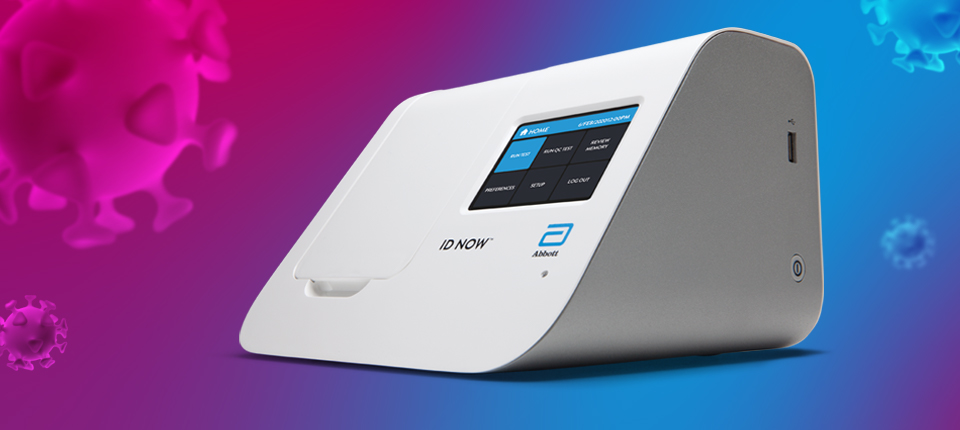Coronavirus testing 3: The rapid test

ID NOW device, courtesy of Abbott press release
Rapid, point-of-care coronavirus test using isothermal amplification
In this final post on coronavirus testing, I’m going to geek out on the new coronavirus rapid test. This will be more technical than my usual stuff.
I was reading about how most coronavirus testing is done (described in post #1) using RT-PCR. That’s reverse transcription of viral RNA into DNA, followed by amplification of the sequence of interest using polymerase chain reaction. Then I learned that on March 27, Abbott, a major American medical device maker, received emergency use authorization from the U.S. Food and Drug Administration (FDA) for a coronavirus test that can deliver a positive result in as little as five minutes. On top of that, it’s a point-of-care test, meaning it can be done on the spot without a laboratory.
That’s a game-changer. Very impressive, and I wanted to know their secret. Clearly Abbott’s test method had to be fundamentally different.
RT-PCR is really great technology, and is widely used for many applications. But in terms of clinical testing for COVID-19, it suffers from two limitations. First, amplification of the target DNA using PCR has to be done in a laboratory, using a machine called a thermal cycler. That means that all specimens obtained from patients must be delivered to a testing lab. They can’t be tested at the “point of care” where the doctor and patient are. Second, PCR takes time—hours, not days, but still much longer than a few minutes. Each round of amplification begins by heating the sample to a high temperature to denature the DNA. Then the sample is cooled (to allow primer annealing and DNA synthesis). And then the process is repeated many times, with the thermal cycler heating and cooling through each cycle.
If Abbott’s new rapid test doesn’t use PCR, how does it detect the virus? I dug around the internet for details. Abbott doesn’t say much about their technology, but I found a 2013 Powerpoint from a scientist at a molecular diagnostics company named Alere. The presentation describes a rapid, point-of-care test for an RNA virus (influenza). Abbott bought Alere in late 2017 for about $5 billion.
The Alere technology is a next-generation molecular diagnostic using isothermal amplification. Basically it’s RT-PCR done at a single temperature (iso- thermal). The underlying principles are the same. The rapid test detects specific viral RNA sequences, which are first reverse transcribed and then amplified and detected. The difference is the amplification is done without thermal cycling, and can be done using Abbott’s toaster-sized ID NOW device in non-traditional settings. Samples don’t have to be transported anywhere. And no laboratory is required. According to the manufacturer, strongly positive samples can give a signal in as little as five minutes. Waiting for a negative result takes thirteen minutes.
Isothermal amplification is exciting new biotechnology. When used properly it has similar sensitivity and specificity to PCR. The technology has been in development for a while, and the potential for point-of-care medical diagnostics has been obvious for years. The SARS-CoV-2 pandemic may be the moment isothermal amplification comes to maturity. Here’s a nice quick review of the topic from January 2019; and an older, more detailed review of the technology. For hard-core molecular technology fans, here is a review of all the technical strategies being used for isothermal amplification. The strategies vary more widely than PCR techniques. (For the record, the Abbott coronavirus test uses nicking enzyme amplification reaction (NEAR).)
Abbott promises availability of 50,000 of these rapid, point-of-care tests per day in the US. That’s a drop in the bucket. A proper science-based strategy to end the lockdown would require twenty times that number. But it’s a start.
Amy Rogers, MD, PhD, is a scientist, novelist, journalist, and educator. Learn more about Amy’s science thriller novels, or download a free ebook on the scientific backstory of SARS-CoV-2 and emerging infections, at AmyRogers.com.
 Do you like my science journalism? Read Science in the Neighborhood and learn, where does my tap water come from? How are mosquitoes managed? What happens after I flush? Where does my electricity come from?
Do you like my science journalism? Read Science in the Neighborhood and learn, where does my tap water come from? How are mosquitoes managed? What happens after I flush? Where does my electricity come from?
0 Comments
Share this:



0 Comments